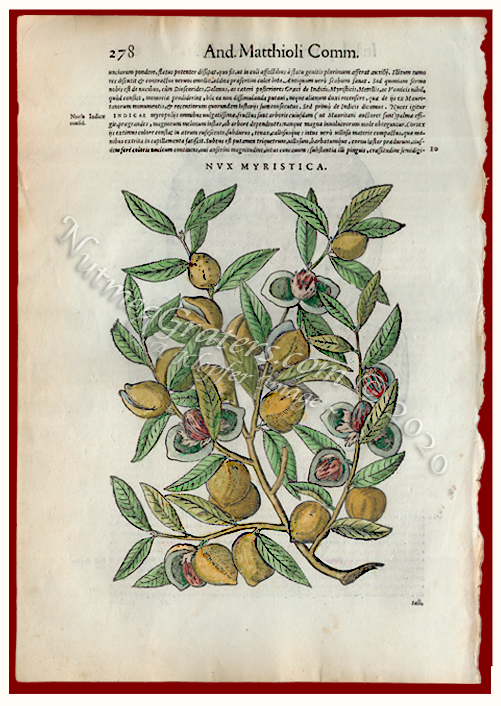NutmegGraters.Com



"NUX MYRISTICA" ~ 1565 ~ Matthioli ~ Senensis Medici, Commentarii in ʃex libros Pedacii Dioʃcoridis Anazarbei de Medica materia, Iam Denvo Ab Ipso Avtore Recogniti Et Locis Plvs Mille Avcti
PRINT ENTITLED: Nux Myristica.
SOURCE: Senensis Medici, Commentarii in ʃex libros Pedacii Dioʃcoridis
Anazarbei de Medica materia, Iam Denvo Ab Ipso Avtore Recogniti
Et Locis Plvs Mille Avcti.
AUTHOR: Petri Andreæ Matthioli.
PUBLISHER/EDITOR: Vincenzo Valgrisi ~ "ex officina Valgrisiana".
DATE OF PUBLICATION: 1565.
PLACE PUBLISHED:
Venice, Italy.
SCOPE AND PURPOSE OF PUBLICATION: This is a medical herbal text.
PRINT METHOD: Xylography (wood block printing) with added handcoloring.
PAPER TYPE: Chain Laid Paper with watermark; sheet size W. 9½" (25 cm) x L. 14" (35 cm).
HISTORY: This Myristica Fragrans engraving is from a work by Petri Andreæ Matthioli (1501~1578). He obtained his medical degree at Padua, Italy in 1523, and went on to create twelve significant works, all published between 1533 and 1579. His first major text Di Pedacio Dioscoride Anazarbeo Libri five Della historia was printed in 1544. However, the engraving above comes from his later work, Senensis Medici, Commentarii in ʃex libros Pedacii Dioʃcoridis Anazarbei de Medica materia, Iam Denvo Ab Ipso Avtore Recogniti Et Locis Plvs Mille Avcti, published 1565. Senensis Medici, Commentarii… is Matthioli's first illustrated herbal and a large 636 page volume. He soon translated this work into French (1561), Czech (1562) and German (1563).
Although beautifully depicted, his nutmeg engraving in not accurate in detail. Myristica Fragrans is everbearing; thus the tree is ever flowering and fruiting simultaneously throughout the entire year. Notice the absence of any tiny white flower buds or any developing small, green unripened fruit. The leaves are correctly formed, yet the fruit does not actually split to the wide degree as illustrated. Further, no details are illustrated to distinguish any of the significant differences between male and female trees. Matthioli relied on information derived from "such as reported from two Indian shores surveys" ~ seemingly inaccurate sources and there is no evidence that Matthioli ever first handedly witnessed a nutmeg tree.
Associated with the engraving, two text pages written in Latin (Pages 278 & 279) briefly describe "Nux Myristica", and list various medical treatments: "to sweeten the mouth", "to cleanse the liver", "settle the stomach", "improve breathing", "reduce muscular and joint pains", "improve sexual function", "for treatment of the uterus", etc.
Matthioli was both successful and influential in his practice as a medical doctor and an herbalist. He periodically relocated throughout Italy, and he maintained a medical practice in association with the highest level clergy and nobility of his time (including Emperors Ferdinand and Maximilian II). When in Gorizia, the local inhabitants presented him with a precious gold chain and locket (as seen within all portraits of him). Married three times, he had several children. His primary interests remained the study of medical botany. Matthioli died of the plague in 1578.
The publisher of Matthioli's Senensis Medici, Commentarii… was Vincenzo Valgrisi (Circa 1490~1572+). Valgrisi printed approximately 200 significant publications. He is recognized for utilizing full page illustrations to precede his text sections, instead of the small vignette illustrations that were commonly used during this era. These large woodblock prints required a high degree of expertise to craft and were very labor intensive. Valgrisi's illustrations were created using woodblock prints that would provide sharp, precise and detailed edging and margins. Senensis Medici, Commentarii… is a significantly large and detailed early body of work.
[KLOPFER article © January 2020]